|
Situated
between India and China, Southeast Asia has been the birthplace of several
cultures, some of which rank among the world’s greatest civilizations. Among
the Indianized kingdoms which sprang up in Southeast Asia before the Common era,
the great Khmer civilization and its capital, Angkor, in modern day Cambodia.
The advent of Indians in Southeast Asia has hardly a parallel in history. In
view of the ethnic affinities between the prehistoric Austro-Asiatic races of
India and those of Suvarnabhumi, contact between the two regions may well go
back to the remotest antiquity. Most of the countries of Southeast Asia came
under the cultural and religious influence of India. This region was broadly
referred to by ancient Indians as Suvarnabhumi (the Land of Gold) or
Suvarnadvipa (the Island of Gold). Vedic Indians must have charted Java,
Yawadvip, thousands of years ago because Yawadvip is mentioned in India's
earliest epic, the Ramayana. The Ramayana reveals some knowledge of the eastern
regions beyond seas; for instance Sugriva dispatched his men to Yavadvipa, the
island of Java, in search of Sita.
The
whole area was so influenced by India, that according to a European scholar who
wrote in 1861, that "the Indian countries situated beyond the Ganges hardly
deserve the attention of History." The various states established in this
region can therefore be called Indianized kingdoms. Invasion nor proselystism
was by no means the main factor in the process of Indianization which took place
in the Indian Archipelago. International trade was very important.
Angkor Wat indeed deserves to play the leading part not only because of its
exceptional artistic and architectural achievements but also on account of the
hydrological, agricultural and ecological problems solved there.
Angkor
wat is
often hailed as one of the most extraordinary architectural creations ever
built, with its intricate bas-reliefs, strange acoustics and magnificent soaring
towers.
Angkor
Wat, originally named Vrah
Vishnulok
- the sacred abode of Lord Vishnu, is the largest temple in the world. It was
built by King Suryavarman II in the 12th century.
The Sanskrit Nagara (capital) was modified by the Cambodian tongue to Nokor
and then to Angkor.
The word Angkor is derived from the Sanskrit word 'nagara' meaning 'holy city'.
Vatika is Sanskrit word for temple. "The city which is a
temple," Angkor Wat is a majestic monument, the world's largest religious
construction in stone, and an architectural masterpiece. The
Khmers adhered to the Indian belief that a temple must be built according to a
mathematical system in order for it to function in harmony with the universe.
Distances between certain architectural elements of the temple reflect numbers
related to Indian mythology and cosmology. The
sheer size of the place leaves visitors in awe and the complex designs
illustrate the skills of long gone priest architects. Every spare inch has
been carved with intricate works of art.
The sculptures of Indian icons produced in Cambodia during the 6th to the
8th centuries A D are masterpieces, monumental, subtle, highly sophisticated,
mature in style and unrivalled for sheer beauty anywhere in India says Philip
Rawson. The scale of Angkor Wat enabled
the Khmer to give full expression to religious symbolism. It is, above all else,
a microcosm of the Hindu universe.
It is frequently said that Angkor
was 'discovered' by the Europeans but this is patently nonsense and simply
reflects a Eurocentric view. The Khmer never forgot the existence of their
monuments. French naturalist Henri Mouhot
stumbled across the city complex of Angkor Wat while on a zoological expedition.
He
was overwhelmed by the magnificence of these ruins hidden in the jungle and
wrote:
“One of these temples – a rival to that of Solomon, and erected by some
ancient Michael Angelo - might take
its place besides our most beautiful buildings – Grander than anything left to
us by Greece or Rome …it makes the traveler forget all the fatigues of the
journey, filling him with admiration and delight, such as should be experienced
on finding a verdant oasis in the sandy desert."
The
grandeur of this ancient civilization is truly astounding. Covering an area of
one square mile, Angkor Wat is one of the largest temple complex in the world.
The temple is dedicated to the Lord Vishnu from whom the king was considered a
reincarnation. Essentially a three-layered pyramid, Angkor Wat has five
distinctive towers, 64 meters high. On the outer wall are eight panels of
bas-relief depicting scenes of Hindu epics Ramayana and Mahabharata. These
relics of past grandeur bear mute testimony tone of the least known yet most
glorious chapters in the history of mankind: that of the classical culture of
‘Greater India.’
Unlike
other countries, Cambodia does not minimize Indian influence on the local
culture. On the contrary, the people of the country generously acknowledge it.
Prince Norodom Sihanouk of Cambodia recalled the close cultural ties that have
existed for two thousand years between India and Cambodia. He said: "When
we refer to 2000 year old ties which unite us with India, it is not at all a
hyperbole. In fact, it was about 2000 years ago that the first navigators,
Indian merchants, and Brahmins brought to our ancestors their gods, their
techniques, their organization. Briefly India was for us what Greece was for the
Latin Occident."

 
History
of Kambuja
Architectural Symbolism
Why
does Angkor Wat face West?
Angkor Wat: A City within a City
Lintels and Apsaras
***
For the rest of
the chapter refer to the links listed below:
Sacred Angkor
Sacred Angkor part 3
Sacred Angkor part 4
History of Kambuja
Southeast Asia did not become a cultural battlefield between
China and India. In the field of religion, for instance, there was no rivalry
between the two great Asian peoples to save souls in Southeast Asia. On the
contrary, the Chinese adopted Buddhism, which was introduced from India by way
of central Asia at the court of the eastern Han emperor in the 1st
century AD. Throughout the first millennium, scholars and pilgrims from China as
well as Southeast Asia visited places of worship and scholarship in India. Many
Chinese scholars and pilgrims stopped halfway in Sumatra and Borneo to learn
Sanskrit and Pali before proceeding to India for advanced study. China and
Southeast Asia both were areas of Indian religious influence in this period.
Most of Southeast Asia followed the
Indian cultural patterns. The relative acceptability of Indian
culture may be further attributed to geographical commonness, relative lack of
Indian political ambition in the region, and the sate of commerce between India
and Southeast Asia. Geographically, India and Southeast Asia share the tropical
monsoon climate, with all its implications for a way of life based on irrigate
agriculture. Indian culture was welcome in Southeast Asia because it came
without political strings. Also, it should be noted that commerce had been an
important carrier of culture throughout history. Traditional Chinese shyness
towards the sea left the field largely to Indians at first and, later, to the
Arabs, Persians, and to the Southeast Asians themselves.
However, the large scale acculturation of Southeast Asian
elite on the Indian pattern could not have been the work of Indian traders, who
belonged to the Vaishya class, or sailors, who came from the Shudra group.
Indeed the prime agents of the process of Indianization were the Brahmins, the
priestly class, who had knowledge of the sacred lore, the rites and the rituals
and laws. The initiative for the Indianizing process in Southeast Asia most
certainly came from the region’s ruling class, who invited Brahmins to serve
at their courts at priest, astrologers, and advisers.
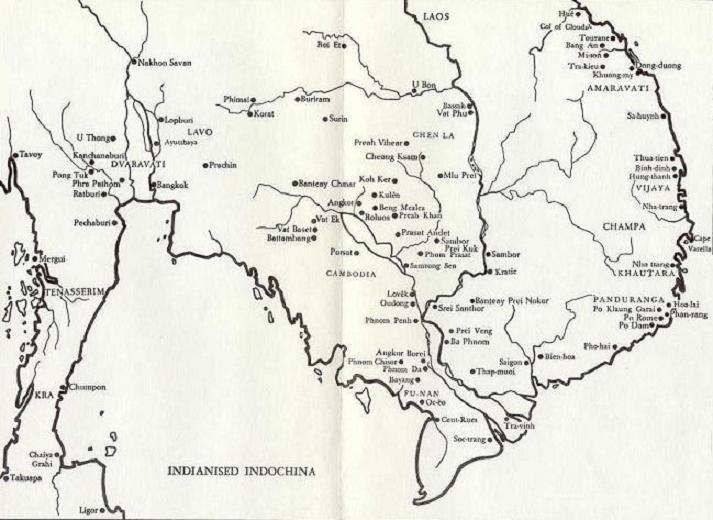
Map
of Indianized Indochina or Suvarnabhumi.
Hindu
names like Dvaravati, Amravati,
Panduranga and Me Kong (Ma Ganga) many others. Philippines was
known as Panyupayana and Borneo was known as Varuna Dvipa.
For
more on The Glorious Hindu Legacy: Indic influence in Southeast
Asia refer to the chapters under Glimpses
XII to Glimpses
XIX and Suvarnabhumi.
***

The Khambuja royalty, traced its descent from
Rishi Kambu Svayambhuva, the King of Aryadesa (India) and the apsara Meera, which
is another version of the recurrent motif of foundation myths of royal families
in South India.
***
Chenla is claimed to have been the original home of the Khambuja
people.
The Khambuja royalty, traced its descent from
Rishi Kambu Svayambhuva, the King of Aryadesa (India) and the apsara
Meera, which
is another version of the recurrent motif of foundation myths of royal families
in South India.
Kambuja (Cambodia) according to tradition was established by Kambu Svayambhuva
after whom the country was named Kambuja. Some of its famous rulers bore names
ending in Varman as in South Indian; examples are Jayavarman,
Yasovarman, and Suryavarman.
The
two earliest known kings are Srutavarman and his son Sreshthavarman, who secured
Chenla’s freedom from Funan. About the middle of the 6th
century, when the last king of Funan, Rudravarman died, the king of Chenla,
Bhavavarman – possibly a grandson of Rudravarman of Funan –
underttok to conquer Funan with the help of his brother Chitrasena.
A
good deal is known of Bhavavarman from inscriptions, one of which, written in Sanskrit verse,
announces the consecration by the King, of a Sivalinga
named Tryambaka. Another describes him as King of Kings, strong as
Mount Meru. When he died in 598 the unification of the two kingdoms was well
advanced, and he has been described, therefore, as the founder of the glory of
Kambujadesa. After his death, his brother, Chitrasena
ascended the throne as
Mahendravarman. He built numerous Shiva
temples throughout his domains. All the known inscriptions of Mahendravarman
resemble Pallava inscriptions of the early 7th century. In marked
contrast to Funan and other Southeast Asian states which frequently sent
embassies to China, Chenla dispatched its first embassy to China in 616-617,
during Chitrasena’s reign.
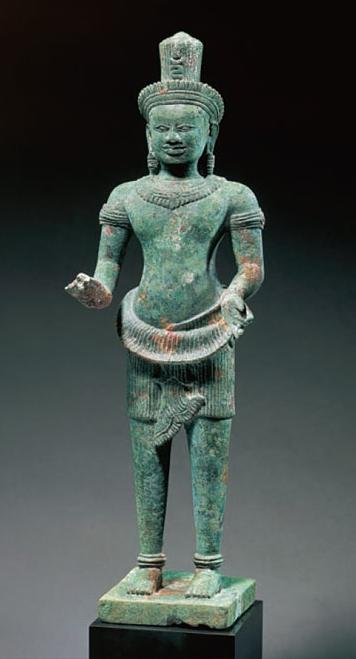
Lord Shiva,
bronze 11th century. Cambodia.
King Mahendravarman built numerous Shiva temples throughout his domain.
***
After
his Chitravarman’s death, his son Isanavarman ruled over the whole of
Cambodia, Cochin China, and the valley of the Mun River to the north of the
Dangrek Mountains. On the site of the modern Sambor Prei Kuk (Kampong Thom) on
the Mekong River, he founded a new capital city, called after his name Isanapura.
The Khambuja or the Khmer Kingdom gradually emerged from the
fusion of Chenla and Funan, and became the most powerful state in Indochina.
It survived for almost seven centuries and attained an
unparalleled height of political prestige and cultural advancement until it was
destroyed by the Thais in the 15th century. At about the same time
this empire emerged, the Pyu kingdom of Sri Ksetra in Burma, the Mon kingdom of
Dvaravati in Siam, and the Empire of Sri Vijaya in Indonesia were flourishing.
The seventh century was a formative one in Southeast Asia.
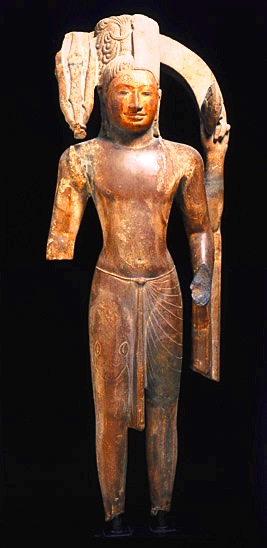
Lord
Harihara: Shiva and Vishnu united into a single body was the main feature
of this period.
Harihara 6th century;
sandstone from Ashram Maharosei
(6th C.) a Hindu-style sandstone temple built in a style unlike
any other temple in Cambodia.
(image
source: Guimet Museum, France).
***
Until the end of this century, the Khmer kings concentrated
on consolidating their hold over lower Meking (Ma Ganga)
region and around Tonle Sap. Both Hinduism and
Buddhism were practiced, with the former predominating;
Saivism appears to have been the court religion. The
worship of Harihara, in which Shiva and Vishnu are united in a single body, was
the main feature of this period. Most inscriptions are in Sanskrit and the
literary culture was based upon the Ramayana, the Mahabharata, and the Puranas.
Phnom Kulen -- This
is where the 500-year long Age of Angkor began. Phnom Kulen is the mountain on
which Jayavarman II initiated a royal 'devraja' king in 802AD, declaring a
unified and independent Cambodia under a single ruler.
Until the rise of
Jayavarman II the capital of the Kambuja was in the south at Isanapura where the
earliest types of Khmer temples are found, all dedicated to the Hindu religion.
Indian models, especially of the post-Gupta style, were generally imitated, but
the wood originals in India have perished. Indian
influence in early Khmer or Sambor art is so marked that some scholars have
suggested the artists came from India. The statues are extremely beautiful, but
only a few have survived.
The most exquisite of these are the statues of
Harihara, Uma and Lakshmi in the Phom Penh museum.
Jayavarman introduced
into Cambodia with the help of a Brahmin guru, Hiranyadama,
the idea of the Deva Raja (the king-God) which was somewhat similar to that of
the Sailendra King of the Mountain cult. Jayavarman based his power on religion.
He organized the state, founding several capitals – Hariharalaya, modern
Roluous, Amarendrapura, probably built around Akyum, and finally Mahendraparvata
or the Phom Kulen. Excavations on the summit of Phnom Kulen have revealed a
number of temples that were completely hidden by thick forests and were mainly
discovered by Philippe Stern and Henri Mouhot. In style, they provide a link
between pre-Angkor and classical Angkor art.
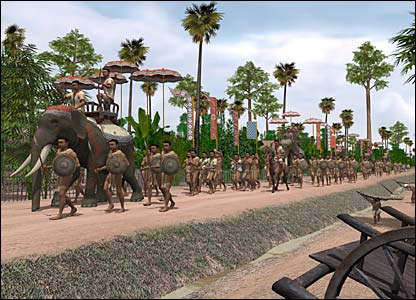 
Angkor wat
procession and scene of battles.
***
The Khmers were accomplished builders; Jayavarman’s
successors built temples enthusiastically. The cult of the King of the Mountain
inspired each king to erect a magnificent shrine to perpetuate his memory. Thus
arose the complex of Angkor Thom. Yasovarman I (889 – 901) was one of the
outstanding rulers of the dynasty, and the founder of the first city of Angkor.
This covered a much larger area than Angkor Thom, which was founded later by
Jayavarman VII at the end of the twelfth century. These two cities partly
overlap, but the former lies outside the southern wall of Angkor Thom.
Yasovarman issued a large number of
Sanskrit inscriptions written in Kavya style and built the Saiva temple of Phnom
Bakheng.
Indravarman
who laid the foundation of Angkor, is said to have studied the monistic Vedanta
philosophy of the great Indian Sage Shankaracharya,
with a Brahmin learned in that tradition.
Hydraulic
Capital
Cambodia reached its peak during the reign of Suryavaman II
(1113 – 1152), the builder of the matchless Angkor Wat, an epic in stone. With
the death of Jayavarman II (1181 – 1220) the kingdom began to decline, falling
finally before the advancing Thais.
Angkor is a derivative of the Sanskrit Nagara, meaning city,
and thom a Khmer word meaning great. Angkor can reclaim the
reputation it once had as a "hydraulic capital".

Hydraulic
Capital - Irrigation channels.

“This architectural work perhaps has not,
and perhaps never has had, its equal on the face of the globe.” -
Henri Mouhot.
Angkor
wat was the size of Los Angeles.
***
Angkow wat covering an area of five hundred acres is the
largest and most impressive temple in the world. According to Henri Mouhot, who
discovered it for the modern world: “this architectural work perhaps has not,
and perhaps never has had, its equal on the face of the globe.”
Since his day, countless people,
both admirers and skeptics, have stood spellbound before this majestic temple of
Vishnu.
A raised causeway of flagstones, lined by a naga-balustrade,
leads from the main road over a moat to the main gate of the temple. This gate
house, which is a spacious building forming the front part of the wall that goes
around the enclosure, is in itself a remarkable creation. A paved road 400 yards
long leads to the temple. At the base, the temple is 223 by 242 yards, and its
main tower is about 80 yards high. Structurally it is a three-stepped pyramid.
Each storey is punctuated by towers at the corners and pavilions in the center.
The main tower is on the third storey. The temple rises steeply in the form of
three concentric rectangular galleries, each double the height of the preceding
one, and connected by stairs and intervening open terraces. The inner most
gallery is dominated by five tall domes, the central one of which dominates the
plain below. The entire building is constructed in sandstone, and if any wood
was used, it has long since perished.
The building has been chiseled with
endless bas-reliefs and beautiful designs and patterns. Flowers, birds, and
dancing maidens decorate the walls. Hundreds of Khmer artists must have spend
their entire lives on the work, yet is impossible to detect a single flaw in
these acres of carved panels. The sculptors of Angkor wat who executed many
scenes from the Ramayana, the Mahabharata, and the Harivamsa, must have had an
intimate knowledge of Indian epic literature. Vishnu predominates but other gods
also adorn the temple with their various incarnations and emanations. The outer
gallery, running around the whole
building, itself contains a half-mile of bas reliefs on the back wall, and there
are about 1750 life-size apsaras, practically everyone in a different,
magnificent head-dress.
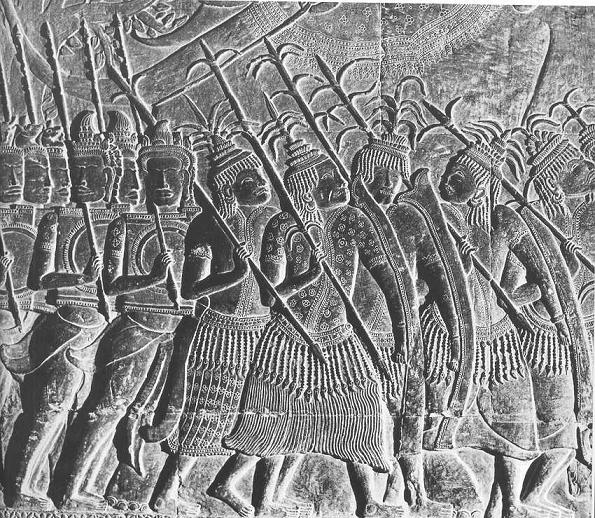
All the princes received training in Indian philosophy and
literature.
A number of persons of apparent Indian origin were present in the
Khambuja kingdom and Brahmins were held in high esteem. For instance,
Hiranyadama came from a janapada in India to teach Tantric texts to the royal
priest, Sivakaivalya.
***
Although the Khmers are so admirably
remembered for their superb achievements in art, they patronized all branches of
Indian learning. All the princes received training in Indian philosophy and
literature. A number of persons of apparent Indian origin were present in the
Khambuja kingdom and Brahmins were held in high esteem. For instance,
Hiranyadama came from a janapada in India to teach Tantric texts to the royal
priest, Sivakaivalya.
When Buddhism became the paramount religion of Cambodia is
uncertain. It had long been flourishing and occasionally enjoyed royal
patronage, but it was never the state religion and never held a dominant
position. It seems likely that Siam, which was first influenced by
Cambodia, later aided Cambodia’s conversion to Buddhism. The change was almost
complete; today Hinduism is practically extinct in Cambodia, except in a
vestigial form in certain ceremonies and festivities. Hindu deities have been
absorbed by Buddhism and relegated to subordinate positions, and even the Hindu
gods in the great temples, such as Angkor Wat, have long been replaced by the
images of the Buddha.
The Thais attacked Angkor Wat several times in the 1300s and
1400s and sacked the seat of the Khmer regime in 1431.
Over
the centuries, numerous different groups - including Thai and Vietnamese
invaders, French colonizers
and Khmer Rouge guerrillas and
the Americans with their carpet bombing
- have trampled over Cambodia's ancient sites, each
contributing to the damage.
To
the French conservators, Angkor was archeological champagne, the best of the
best.
Rescuing it became a technical passion. For 40 years the French
concentrated on arresting further deterioration and by 1970 a hundred-man team,
cranes and heavy cement-mixing equipment were reinforcing the massive jumble of
stonework. Four out of Angkor's nine towers are gone, irretrievably lopped off
by crunching weather forces.
(source: India and World Civilization – D P
Singhal part II p. 124 -
131 and Southeast Asia- Past and present – By D R
Sardesai p. 15 - 20).
Top
of Page
Architectural
Symbolism -
Astronomy and
Cosmology at Angkor Wat
India
was the spark that fired the blaze
One
of the most spectacular structures of astronomical significance that has ever
been built is the temple of Angkor Wat in what is now Cambodia.
Angkor
Wat is the most famous temple at Angkor, a former capital of the Khmer empire.
It was built by King Suryavarman II in the
12th century, and is as immense as it is beautiful.

An astounding aerial view of Angkor wat -
surrounded by water.
Lotus-spired
Angkor Wat rises like a mirrored image above the waters of the moat. Angkor
reflects classic Khmer temple architecture; Its central tower symbolizes sacred
Mount Meru, the surrounding spires chains of mountains, the encircling moat the
oceans.
In
orderly magnificence, the capital unfurled its artistic splendor with the growth
of empire.
The
origins of the temple lie in what may be the world's oldest religious text, the Rig
Veda, one of the four Veda Samhitas of Hindu literature. This text
describes the gods of heaven and earth, including the earthly god Vishnu,
"The Preserver." It is to Vishnu that Angkor Wat is consecrated, and
with more than mere symbolic intent.
***
Surrounded
by a rectangular moat 1.5 kilometers (0.9 mile) long and 1.3 kilometers (0.8
mile) wide, the structure itself consists of two rectangular walls enclosing
three nested rectangular galleries that culminate in a central spire surrounded
by four smaller towers. The straight lines of its moat, walls and galleries are
oriented along the north-south, east-west directions, and unlike most temples in
the area its entrance faces west, being approached by way of a long bridge that
spans the moat.
The
origins of the temple lie in what may be the world's oldest religious text, the Rig
Veda, one of the four Veda Samhitas of Hindu literature. This
text describes the gods of heaven and earth, including the earthly god Vishnu,
"The Preserver." It is to Vishnu
that Angkor Wat is consecrated, and with more than mere symbolic intent.
Hindu temples were built to be earthly abodes for the gods. The central
sanctuary was the most sacred place, directly inline with the vertical axis of
the central spire that provided the connection between the realms of heaven and
Earth. The surrounding architecture of the temple would
then mirror Hindu cosmology, being essentially a mandala in stone—a diagram of
the cosmos itself. Furthermore, the Khmer civilization had by the
time of Angkor Wat's construction incorporated the idea that a king would, after
his death, be transmuted into one of the gods. Hence, it was at Angkor Wat that
Suryavarman II, after his death, was believed to reside as Vishnu.
Astronomical significance:
Astronomy and Hindu cosmology are inseparably
entwined at Angkor Wat. Nowhere is this more evident than in the interior
colonnade, which is dedicated to a vast and glorious carved mural, a bas-relief
illustrating the gods as well as scenes from the Hindu epic The
Mahabharata. Along the east wall is
a 45-meter (150-foot) scene illustrating the "churning
of the sea of milk," a creation myth in which the gods attempt
to churn the elixir of immortality out of the milk of time. The north wall
depicts the "day of the gods," along the west wall is a great battle
scene from the Mahabharata, and the south wall portrays the kingdom of Yama,
the god of death. It has been suggested that
the choice and arrangement of these scenes was intended to tie in with the
seasons—the creation scene of the east wall is symbolic of the renewal of
spring, the "day of the gods" is summer, the great battle on the west
wall may represent the decline of autumn, and the portrayal of Yama might
signify the dormancy, the lifeless time of winter.
The
architecture of Angkor Wat also has numerous astronomical aspects beyond the
basic mandala plan that is common to other Hindu temples. As
many as eighteen astronomical alignments have been identified within its walls.
To mention but three of them: when standing just inside the western entrance,
the Sun rises over the central tower on the spring (vernal) equinox; it rises
over a distant temple at Prasat Kuk Bangro, 5.5 kilometers (3.4 miles) away, on
the winter solstice; and on the summer solstice it rises over a prominent hill
17.5 kilometers (10.9 miles) away.
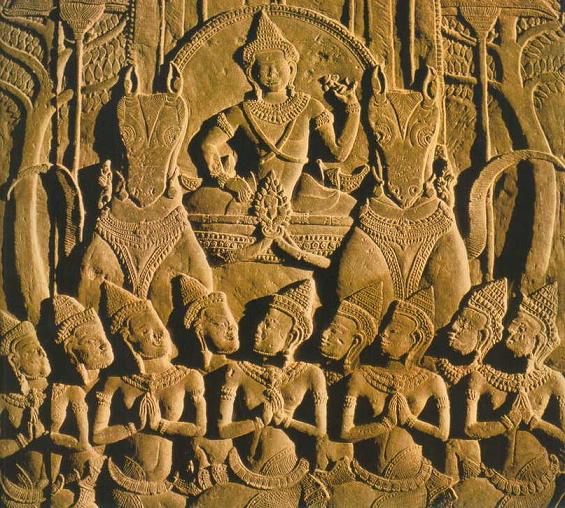
Surya: The Vedic Sun God on his
chariot.
His chariot drawn by prancing
horses, the sun god Surya rides the sky above a chorus of worshippers. In his
right hand he holds a sacred lotus blossom.
(image
source: Splendors
of the Past: Lost Cities of the Ancient World - National
Geographic Society. p.186-190).
***
Finally,
some researchers have claimed that the very dimensions of many of the structures
at Angkor Wat have astronomical associations. These associations emerge from
consideration of the unit of length that was in use at that time, a unit known
as the hat or "Cambodian cubit." There is some question as to how long
a hat was, and indeed its definition may not have been uniformly applied; but a
value of 43.45 centimeters (17.1 inches) for the length of a hat is suggested by
the structures themselves.
Using
this value, archaeologists discovered numerous dimensions of the temple that
seem to have astronomical and cosmological significance—for example, the
following:
-
In the central sanctuary, the
distances between sets of steps is approximately 12 hat. There are
roughly 12 lunar cycles, or synodic months (from full Moon to full Moon,
say—the basis for our modern month) in one year.
Because
of its orbit around the Earth, the Moon's apparent position in the sky relative
to the background stars will appear to shift from night to night. Since it takes
the Moon just over 27 days to complete one orbit (known as its sidereal period),
it will during this time appear to move through 27 successive regions of the
sky. In Hindu cosmology, these regions were known as the naksatras,
or lunar mansions. In some contexts there were 27 lunar mansions, while in other
contexts an additional naksatra containing the star Vega was included, giving 28
lunar mansions.
-
The central tower at Angkor
Wat contains nine inner chambers. If you total the dimensions of all of
these chambers it equals 27 hat in the north-south direction and 28 hat in
the east-west direction, corresponding to the possible number of lunar
mansions. Also, the libraries have lengths measured along their interiors of
16 hat in the east-west direction, and either 12 or 11 hat in the
north-south direction, depending upon whether or not the doorways are
included. Added together, these also give either 28 or 27 hat. Finally, the
north-south width of the libraries measured from the exteriors of the walls
is again 28 hat.
Hindu
cosmology recognizes four time periods, or Yugas, that are represented in the
dimensions of the temple:
-
The length of the Kali-Yuga,
our current time period, is 2 x 603 years, or 432 thousand years.
The width of the moat that surrounds the temple, measured at the water
level, is approximately 432 hat.
-
The length of the Dv
apara-Yuga is 4 x 603 years, or 864 thousand years.
The distance from the entrance to the inner wall is 867 hat.
-
The length of the Treta-Yuga
is 6 x 603 years, or 1,296 thousand years. The distance from the
entrance to the central tower is 1,296 hat.
-
The length of the Krita-Yuga
is 8 x 603 years, or 1,728 thousand years. The distance from the
moat bridge to the center of the temple is 1,734 hat.
Rarely in history has
any culture given rise to a structure that so elaborately and expansively
incorporates its concept of the cosmos. Angkor Wat stands as a striking and
majestic monument in honor of the Universe and our place in it.
(source:
Angkor
- The History of Astronomy - planetquest.org).
The Solar Numbers at Angkor Wat
 Dr
Subhask Kak (1949 - ) is a
widely known scientist and a Indic scholar. Currently a Professor at Louisiana
State University, he has authored ten books and more than 200 research papers in
the fields of information theory, quantum mechanics, and Indic studies. He is a
Sanskrit scholar and is author of Astronomical
Code of the Rig Veda, and India
at Century's End:
Essays on History and Politics. Dr
Subhask Kak (1949 - ) is a
widely known scientist and a Indic scholar. Currently a Professor at Louisiana
State University, he has authored ten books and more than 200 research papers in
the fields of information theory, quantum mechanics, and Indic studies. He is a
Sanskrit scholar and is author of Astronomical
Code of the Rig Veda, and India
at Century's End:
Essays on History and Politics.
He has observed:
"The great Vishnu temple at
Angkor Wat is known to have been built according to an astronomical plan. A
little understood solar formula of the temple is identical to the one in the 2nd
millennium BC Indian text called Shatapatha Brahmana. It was an expression of
the Shatapatha astronomy."
Architectural
plans published by Nafilyan (1969) were examined to Assess possible astronomical
alignments in context of written records of the Khmer empire and specifically
the reign of Suryavarman II (1113-1150AD)
during which the complex was built. Twenty-two
possible alignments are identified and their relationship to bas relief and
Hindu time cycles examined.
Conclusions:
1. The rising sun appears aligned on equinox and solstice days with the
western entrance of Angkor Wat.2. The movements of the moon can be observed from
a variety of positions within the temple, and lunar cycles may have been
recorded in the three sets of libraries.3. The bas reliefs of the third gallery
can be understood in relation to the movements of the sun, which establish their
counterclockwise direction. 4. The measurements of the temple appear
proportional to calendric and cosmological time cycles.
(source: http://arxiv.org/abs/physics/9811040
and http://www.du.edu/~rstencel/Courses/angkor.htm).
Jean Fillozat was the first to perceive that the relief
function could be part of broader astronomical and numerological concepts
embedded in Khmer architecture.
In 1976, a group of American scholars R. Stencel, F Gifford
and E Moron, published a paper revealing a cosmic symbolism created by the
relationship between structures and meaning in the design of Angkor wat. The
theme was considerably expanded by Eleanor Mannikka in her book of 1996. On the
basis of the study of a very large number of measurements of architectural
elements at Angkor Wat, she established that the temple’s dimensions are
encoded with the meanings of Indian cosmology and numerology. She also noticed
that some alignments of the monument’s structures are closely related to
astronomical events. The temple’s architecture is a sort of religious and
astronomical text, a text that could be read by knowledgeable people walking
along its main pathways. For example, as the sun progresses on its annual round,
it illuminates in a specific way the great continuous series reliefs of the 3rd
gallery, revealing a most intriguing relationship between the passage of the sun
and the content of the reliefs. In the first part of the year, it illuminates
the main protagonists of the creation act (Churning of the Ocean of Milk).
During the autumn equinox, on the side of the setting sun, the highlighted
reliefs depict the terrible battle of Kurukshtra. During the dry season, the
north gallery loses the sun, while the reliefs on the south gallery, lit up by
the sun, take as their theme the kingdom of death.
Architectural symbolism
In ancient Cambodia, as in India, the highest religious
authority, the Brahmins, formulated the sacred concepts on which the temple was
based, and the main architect, who was also a religious teacher, carried out its
construction according to the science of sacred architecture (vastu-vidyah).
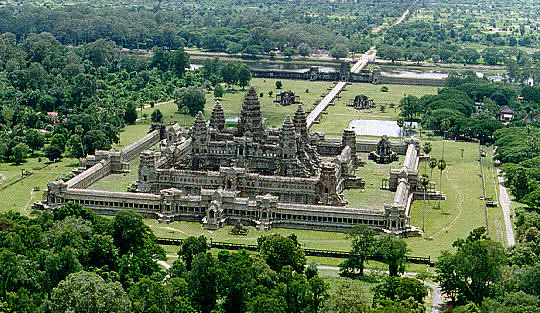
Aerial view
of Angkor wat.
"The great Vishnu temple at
Angkor Wat is known to have been built according to an astronomical plan. A
little understood solar formula of the temple is identical to the one in the 2nd
millennium BC Indian text called Shatapatha Brahmana. It was an expression of
the Shatapatha astronomy."
In ancient Cambodia, as in India, the highest religious
authority, the Brahmins, formulated the sacred concepts on which the temple was
based, and the main architect, who was also a religious teacher, carried out its
construction according to the science of sacred architecture (vastu-vidyah).
***
The Khmer temple was conceived according to the Indian
tradition of a temple-mountain, of being the image of the mountain where the
gods lived, Mount Meru. This mountain was located north of the Himalayas,
surrounded by the four water extensions which separate the continents. Mount
Meru floats over the primordial ocean, symbolically represented by moats or the
baray surrounding the temple. Since this mountain had four peaks with a higher
fifth at the center, the central sanctuary of Angkor Wat had to have a similar
configuration. Moreover, since Mount Meru was the center of the universe in
Indian cosmology, Angkor wat too had to be the center of the cosmos. Thus this
place was charged with sacred meaning.
(source: Sacred Angkor - By Vittorio
Roveda p. 1 – 22).
Symbolic diagram of the Universe ?
 According to Graham Hancock,
Angkorwat and all the temples were conceived by its builders as a symbolic
diagram of the universe. The notion of a land that is
the ‘image of heaven’ on which are built cosmic temples with ‘halls that
resemble the sky’ was an idea that took root in Angkor wat. Angkor wat consists of a series of five inter nested
rectangular enclosures. The short dimensions are aligned with high precision to
true north-south, showing ‘no deviation whatever’ according to modern
surveys. The long dimensions are oriented, equally precisely, to an axis that
has been deliberately ‘diverted 0.75 degrees south of east and north of
west’. According to Graham Hancock,
Angkorwat and all the temples were conceived by its builders as a symbolic
diagram of the universe. The notion of a land that is
the ‘image of heaven’ on which are built cosmic temples with ‘halls that
resemble the sky’ was an idea that took root in Angkor wat. Angkor wat consists of a series of five inter nested
rectangular enclosures. The short dimensions are aligned with high precision to
true north-south, showing ‘no deviation whatever’ according to modern
surveys. The long dimensions are oriented, equally precisely, to an axis that
has been deliberately ‘diverted 0.75 degrees south of east and north of
west’.
The first and outermost of the five rectangles that we find
ourselves looking down on from the air is the moat. Measured along its outer
edge it runs 1300 meters north to south and 1500 meters from east to west.
Its
‘ditch’, (moat) 190 meters wide, has walls made from closely fitted blocks
of red sandstone set out with such precision that the accumulated surveying
error around the entire 5.6 kilometers of the perimeter amounts to barely a
centimeter.
Angkor wat’s principal entrance is on the west side where a
megalithic causeway 347 meters long and 9.4 meters wide bears due east across
the moat and then passes under a massive gate let into the walls of the second
of the five rectangles. This second enclosure measures 1025 x 800 meters. The
causeway continues eastward through it, past lawns and subsidiary structure and
a large reflecting pool, until it rises on to a cruciform terrace leading into
the lowest gallery of the temple itself. This is the third of the five inter
nested rectangles visible from the air and precision engineering and surveying
are again in evidence – with the northern and southern walls, for example,
being of identical lengths, exactly 202.14 meters.
Ascending to the fourth rectangle, the fourth level of Angkor
Wat’s gigantic central pyramid, the same precision can be observed. The
northern and southern walls measure respectively 114.24 and 114.22 meters. At
the fifth and last enclosure, the top level of the pyramid – which reaches a
height of 65 meters above the entrance causeway – the northern wall is 47.75
meters in length and the southern wall 47.79 meters.
According to a study
published in the journal Science, these
minute differences, ‘less than 0.01 percent’, demonstrates an ‘astounding
degree of accuracy’ on the part of the ancient builders.
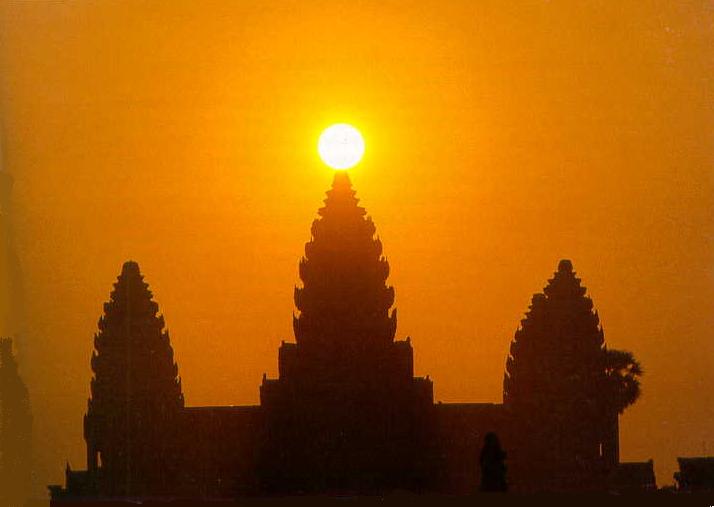
The sun
rising over the central tower of Angkor wat at dawn on the Spring equinox.
Angkor wat is
the largest and most elaborate single edifice in the entire Angkor scheme.
***
The Draco-Angkor correlation
The principal monuments of Angkor model the sinuous coils of
the northern constellation of Draco. There seems to be no doubt that a
correlation exists: the correspondence between the principal stars of Draco and
at least fifteen of the main pyramid-temples of Angkor are too close to be
called anything else.
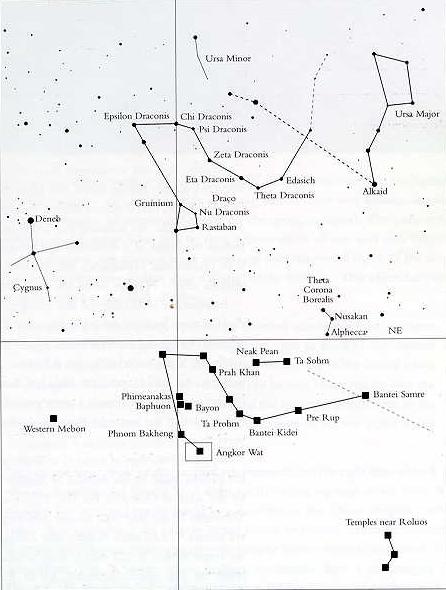
The Angkor-Draco
correlation.
(image
source: Heaven's
Mirror: Quest for the Lost Civilization - By Graham Hancock and Santha Faiia p. 115 - 199).
***
Cycles of the Ages
A detailed survey of Angkor Wat published in Science
magazine in July 1976 reveled that even the causeway
incorporates cosmic symbolism and numbers encoding the cycles of
time.
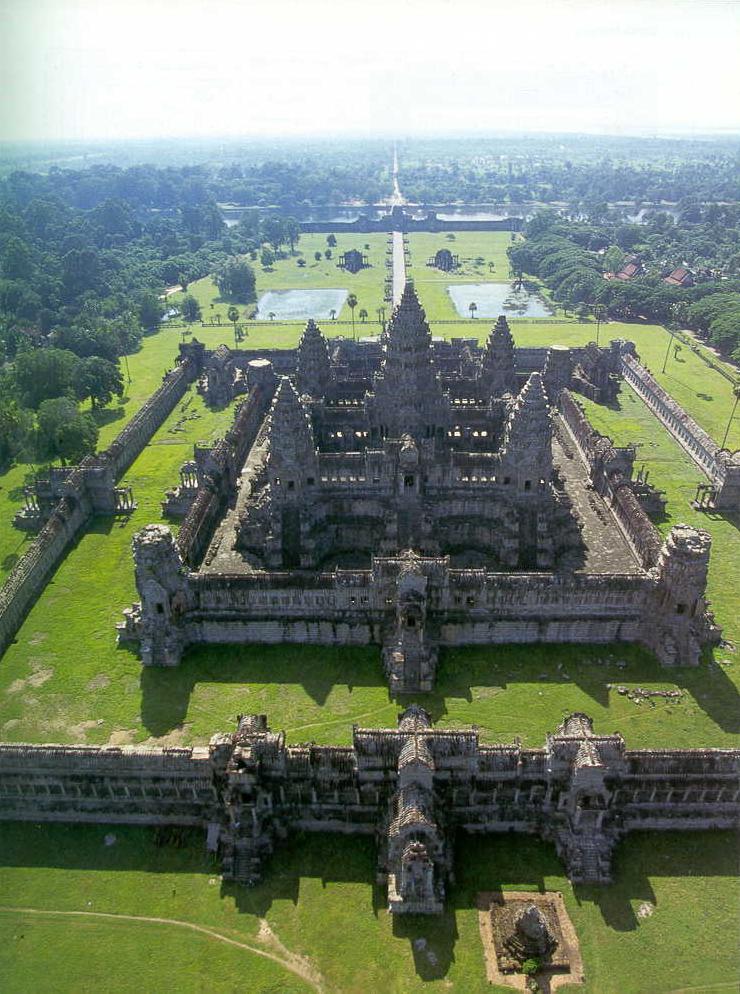
The
axis of the arrow-straight causeway of Angkor can be seen to
extent beyond the temple's moat and to reach out towards the
distant horizon - showing that its builders thought expansively,
in very large-scale terms. Within its moat, all the dimensions of
the temple are precisely calibrated to express a grand
cosmological and numerological scheme related to the precession of
the equinoxes.
***
After establishing the basic unit of measure used in Angkor
as the Khme hat (equivalent to 0.43434 meters) the authors of the
survey go on to demonstrate that axial lengths along the causeway
appear to have been adjusted to symbolize or represent the great
‘world ages’ of Hindu cosmology:
“These periods begin with the
Krita Yuga or ‘golden age’ of man and proceed through the
Treta Yuga, Dvarpara Yuga and Kali Yuga, the last being the most
decadent age of man. Their respective durations are 1,728,000
years; 1,296,000 years; 864,000 years; and 432,000 years.”
It therefore cannot be an accident that key sections of the
causeway have axial lengths that approximate extremely closely to
1,728 hat, 1,296 hat, 864 hat, and 432 hat – the yuga lengths
scaled down by 1000. ‘We propose’, conclude the authors,
‘that the passage of time is numerically expressed by the
lengths corresponding to yugas along the west-east axis.”
Angkor wat’s dominant feature is
its long and massive east-west axis which locks it
uncompromisingly to sunrise and sunset on the equinoxes. In
addition, the temple is cleverly anchored to ground and sky by
markers for other key astronomical moments of the year. For
example, reports Science:
“It is interesting to note that there are two solstitial
alignments from the western entrance gate of Angkor Wat. These two
alignments (added to the equinoctial alignment already
established) mean that the entire solar year was divided into four
major sections by alignments from just inside the entrance of
Angkor Wat. From this western vantage point the sun rises over
Phnom Bok (17.4 kilometers to the north-east) on the day of the
summer solstice…The western entrance gate of the temple also has
a winter solstice alignment with the temple of Prast Kuk Bangro,
5.5 kilometres of the south-east.”
(source: Heaven's
Mirror: Quest for the Lost Civilization - By Graham Hancock and Santha Faiia p. 115 - 199).
Top
of Page
Why
does Angkor Wat face West?
Angkorwat: Not a Funerary place or a Mausoleum
Henri Parmentier writes
in his book, Guide to Angkor:
"The temple of Angkor Wat, contrary to most other
monuments which face east, extends from west to east, this transposition is
doubtless explained by the fact that it was a funeral temple."
George Coedes writes of Angkor
Wat:
"It is a masterpiece of Khmer art, built during the life
time of the King to serve him afterwards as a funeral temple in which he was to
be deified as a statue of Vishnu with the posthumous name of Paramavishnuloka."
Win Swaan in his book, Lost
Cities of Asia writes
"Though many Khmer temples seem to have fulfilled both
these functions (temple and mausoleum), at Angkor Wat alone were the death-centred
attributes triumphant and paramount. Thus, it alone is oriented not towards the
source of light and life, the east; but towards the west, the direction
associated with the setting sun, darkness and death."
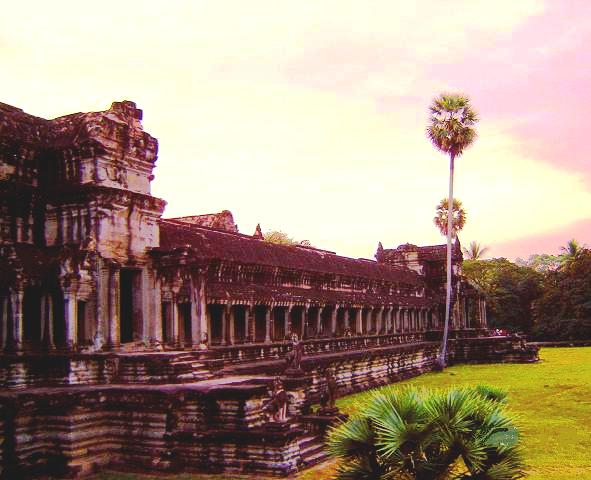
The only way of seeing the bas relief of third enclosure is by
circling it in anti-clockwise direction. This is simply because the Devanagari
script is written from left to right and so is art and sculpture.
(image
source: webmaster's own collection of
photos taken during a recent visit).
***
Some scholars have advanced another argument that one has to
move in anti-clockwise direction a full circle to see the bas-reliefs of Angkor
Wat’s third enclosure, which is also the direction of going round a funeral
pyre, thereby concluding that Angkor Wat is a funerary temple. However, even if
Angkor Wat was not a funerary temple, the only way of
seeing the bas relief of third enclosure is by circling it in anti-clockwise
direction. This is simply because the
Devanagari script is written from left to right and so is art and sculpture. To
see a sculpture of 60 meters or more in length, there is no escape from moving
left to right, and hence circling in the anti-clockwise direction.
Donatella Mazzeo and Chiara Silvi
Antonini rightly observe:
"At the time when he set about building his monumental
temple-mountain Suryavarman II confronted a problem: the finding a site
sufficiently vast to enable him to construct an edifice worthy of his greatness
and his aspirations. Whatever the layout of the city of Angkor was at this time,
including the area of ancient Yasodharapura and of the future Angkor Thom, the
constructions of the 10th and 11th century occupied a
considerable part of the available land. As a result, Suryavarman chose the
southeast corner of Yasodhapura, a space evidently free of buildings of durable
materials, yet one where he could take advantage of the network of canals laid
out by Yasovarman for his capital."
It is plainly evident that the most
appropriate access route to the site of Angkor Wat temple was from the west.
Attributing unsubstantiated explanations or meaning to a fact of purely physical
constraint is unwarranted.
***
Hindu traditions dominated Angkor
civilization up to the 13th century even if some
sovereigns of this period had Buddhist leanings, or were even devout Buddhists. King
Suryavarman II (1113-1150), the builder of Angkor Wat was a devotee of Lord
Vishnu. In the Hindu tradition, no one ever builds a funerary temple or
mausoleum for the simple reason that the mortal remains, with a few exceptions,
are cremated and the ashes left over are consigned to the waters. The
philosophical understanding behind cremation is that this body made of five
basic elements, namely Earth, Water, Air, Space and Fire, returns to those
elements after the migration of the soul.

A Shiva Linga
in the temple of Prasat Kravan with images of Lord Vishnu crossing the Ocean.
Shiva-lingam
is a sign by which Shiva is symbolized.
Linga means a "mark" in
Sanskrit. It is a symbol that points to an inference. The Linga is only the
outward symbol of the formless being, Lord Siva— Lord Siva incarnate, who is
the indivisible, all-pervading, eternal, auspicious, ever-pure, immortal essence
of this vast universe, who is the undying soul seated in the chambers of one's
heart, who is one's Indweller, innermost Self or Atman and who is identical with
the Supreme Brahman.
Shiva
is
represented by the Lingam or Mark, which is manifestly the
Creative power of Divinity. To
the Westerner, imbued with the Puritan and Victorian ethics, it is difficult to grasp the
meaning of a Shiva linga. Prudery
was quite unknown to ancient Indian artists, who had no conception
of ‘the sins of the flesh’ with which Western civilizations
are so preoccupied even today.
***
But it is also true that the palace and the dearest
possessions belonging to the departed person, become a kind of a memorial for
successive generations. Thus, in case of Angkor
chakravartins, their linga or personal gods and the shrines housing them, were
their most sacred possessions. These temples were not for public
prayer or assembly but for the exclusive worship by the King of his personal
God. The successor King thus had a new personal shrine built,
and the shrine of his predecessor was always regarded with utmost reverence and
high esteem. They thus became not mausoleums
or funerary temples, as many western scholars have suggested, but revered
memorials.
As a rule, Hindu temples face north or east, which is linked
to the most effective use of the sun. But where circumstances do not permit,
temples can face south or west. There are temples in
India facing west. Furthermore, the main Garbha Griha or Sanctum Santorum at
Angkor Wat does not face west alone but faces all the four directions in an
identical manner. The approaches to the main shrine under the central tower are
identical from all directions. Only the main royal approach to the whole temple
complex is from the west, which, as already seen, was the only logical approach
from the King’s main dwelling site.
***
As for deifying Suryavarman II as stuate of Vishnu in Angkor
Wat with the posthumous name of “Paramavishnuloka” it should be understood
that all Gods are formless as nobody has seen them. All forms of manifestations
as seen in pictures of statues are the individual maker’s impressions. It was,
therefore, natural for the craftsmen to see the image of their Kings in those of
the Gods. King Jayavarman VII as Avalokitesvara is omnipresent in all the
monuments built by him. This was not dictated by the King himself.
The name “Paramavishnuloka” is nothing majestic or
deifying. It is a combination of
three Sanskrit words – Parama (meaning great), Vishnu and Loka (meaning place
or shrine), i.e. a “Great Vishnu Shrine” which it was, and still is. The
suffix Loka is not to be associated with the name of a person, but of place. In
this respect Coedes has misinterpreted Paramavishnuloka to mean Suryavarman’s
posthumous name…Had Angkor Wat been meant for deifying Suryavarman II, it
should have been called after his death “Suryavarmanpura” or “Paramasuryavarmanloka”,
like “Yashodharpura” , “Mahendrapura” or “Bhimapura.” For example,
Jayavarman II’s capital at Rolous was called “Hariharalaya” but this was
not his posthumous name.
(source: Saving Angkor - By C M Bhandari p. 151 - 153).
Top
of Page
Angkor
Wat itself, built to honor the Hindu god Vishnu, is often hailed as one of the
most extraordinary architectural creations ever built, with its intricate bas
reliefs, strange acoustics and magnificent soaring towers.
The grandeur of this ancient
civilization is truly astounding. Covering an area of one square mile, Angkor
Wat is one of the largest temple complex in the world. The temple is dedicated
to the God Vishnu from whom the king was considered a reincarnation. Essentially
a three-layered pyramid, Agkor Wat has five distinctive towers, 64 meters high.
On the outer wall are eight panels of bas-relief depicting scenes of Hindu epics
Ramayana and Mahabharata.

Garuda.
Lord Vishnu's mount and Lord Shiva.
(image
source: Angkor: Splendors of the Khmer Civilization -
By Marilia Albanese p. 34).
***
Erected by Suryavarman II (1113- 1150) , the famous and most
glorious of all Khmer rulers, Angkor Wat is indeed the largest and the most
beautiful of all the temples built in the Indo-China peninsula. Remarkable for
its quality and its perfect feeling for form and volume, its over-all lay-out
and the arrangement of its various components, this magnificent monument is the
masterpiece of classical Khmer aesthetics and city-planning.
Angkor Wat lies in the southeast sector of the ancient city
of Yosodharapura, built in the late 9th century and surrounded by an
enormous moat the perimeter of which measures 10 miles. This part of the urban
complex had to be wholly reorganized in order to make room for Suryavarman
II’s gigantic creation. The temple complex takes up almost all the available
space. The temple itself is surrounded by a moat almost 660ft wide contained
within a rectangular enclosure 4925 ft long and 4270 ft wide covering an area of
about two square km. The park surrounding the temple covers an area of one
million square meters (1,200,000 sq.yd) minus 100,000 sq. meters occupied by
various buildings and galleries which divide the park into four square basins.
What can we conclude from these colossal dimensions? They bear witness to the
fact that the great temple-palaces were the center of urban complexes of which
the stone structures alone have survived.
Angkor Wat attests its architect’s feeling for sculptural
form and arrangement. Crossing the threshold of the propylaea, one gets a
sensational view of the façade of the main temple culminating in five towers,
the quincuncial arrangement of which resembles a tiara. One is truly struck with
astonishment at this amazing and enrapturing sight. The size and magnificence of
the monument by no means detract from its refinement. As a whole, it bears
witness to an authentically dynamic perception of space. Khmer art reaches one
of its peak here.
On the inside a kind of pictorial chronicle of the Khmer
empire embellished with legendary scenes from the Ramayana and Mahabharata
portraying all the fabulous beings in Hindu mythology unfolds here before our
eyes. These enormous “frscoes” carved in fine sandstone display an
extraordinary feeling for monumental composition. The sculptural carvings cover
an area of almost 1200 square meters (1440 sq.yd).
The
Wealth of Angkor
Yet this stupendous achievement makes us ask one meanly
materialistic question: what did the Khmer kings owe their wealth to? What
enabled them to produce such an enormous monument? The construction of the
temple of Angkor Wat called for 350,000 cubic meters of building materials, ie.
Almost one million metric tons of rock which had to be brought from the far-off
sandstone quarries situated near Kulen, 40 km (25 miles) north of Angkor. But
once again, how was it possible to support the tens of thousands of workmen
employed in this tremendous undertaking: quarrymen, cart and raft-makers, stone
cutters, masons, sculptors etc? Where could they get the raw materials for the
bronze statues, so few of which have survived, the doors set off with gold and
silver inlays, the brocade and gauze adorning the altars where offering were
placed? How did they pay the artists and craftsmen who worked on this marvelous
temple for decades and decades?
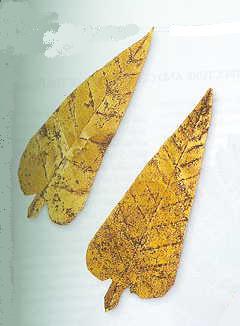

Gold leaves and
delicate gold pattern.
The Khmers
used precious metals in their buildings; the inner walls of the cells were
covered with bronze plates and the cusps of some temples also have been plated.
Everything has been stolen, but this gold panel gives some idea of the wealth of
the Empire.
***

Miniature
shrine structure.
At the corner
of the temple roofs there were antefixes like this one, originally from Bantaey
Sri. They reproduce the structure of the shrine in miniature, as in the
architecture of southern India, by which Khmer architecture was inspired.
(image source: Angkor:
Splendors of the Khmer Civilization - By Marilia Albanese).
***
The Birth of Rice Plantations - The Indian traders who settled on the southern coast first
introduced advanced farming methods into Southeast Asia. Thanks to them, the
first rice plantations appeared on the peninsula. The variety of rice grown was
obtained by selection. It was already sown in India in the third millennium B.C.
To ripen, this rice requires constant care and a well regulated irrigation
system. The Mekong delta was the center of this agricultural system based on
irrigated rice-fields.
The Creation of Artificial Lakes or Barays - To go from simply cultivating rice-fields yielding one crop a
year to conceiving the desire to make them produce two or three, a very
important step must be taken. This progress implies the will to free human
communities from their subservience to the rhythm of nature. This step was taken
by the rulers at Angkor when they decided to create enormous artificial
reservoirs, known as barays. The main purpose of these reservoirs was a better
distribution of the region’s water resources, above all rainfall which some
months is extremely abundant but more often wholly lacking.
The irrigation system which, between the 8th and
10th century transformed Angkor into a genuine rice factory, was
basically organized according to these simple principles. Water, indispensable
for agriculture, was also one of the fundamental factors taken into account by
architects and city-planners. Canals proceeding from the baray brought fresh
water to the town’s inhabitants. Waster water was carried away by the current.
The water in the moats traced the town boundaries and also served to defend
Khmer urban centers.

Goddess
Lakshmi, the Bestower of Success.
***
Scientific
Agriculture
The rulers adopted a kind of “scientific” agriculture in
which rice was looked upon as a bedding plant. Instead of going through the
whole process consisting of plowing, sowing, irrigating and reaping on the spot
in the flooded fields, the Khmers realized that it would be advantageous to sow
the rice in beds where the shoots come up very thick; when they reach a height
of 8-10 inches, these shoots were transplanted in the freshly harvested, plowed
and submerged fields. These beds take up only a tenth of the land under
cultivation. They make it possible to sow a second time before reaping the first
crop. This method was capable of transforming Angkor into the tremendous rice
factory which was the main cause of its rulers’ wealth and power and made it
possible to erect their admirable temples.
The term “environment” is nowhere more meaningful than at
Angkor. The capital of the Khmer kingdom is indeed perfect example of how man
can give nature a helping hand. Without the irrigation system, the birth of an
important civilization would have been altogether impossible in the heart of the
hostile jungle. Angkor is actually a miracle, an agreement entered into by
earth, water, men and gods. The uniting of these four factors thoroughly changed
the appearance of the plain in the Angkor area. The rice plantations make it
resemble a chequer-board. Thanks to them, this part of the world has become an
ecological masterpiece. Rice and religion link up a whole series of phenomenon
controlling national development.
(source: The Cultural history of Angkor –
By Henri
Stierlin p. 1 – 54).
Its sheer size and scope reflect the power, resources, and
loyalty that the Khmer Empire had achieved. The
buildings of Angkor Wat are built solely from sandstone from a quarry a fair
distance away. Engineers estimate that the amount of sandstone used in
Angkor Wat is at least equivalent to the volume of stone used in the great
Egyptian pyramid of Khafre. This is yet another indication of
the power that the Khmer Empire had reached at the time of Angkor Wat’s
construction.
Top
of Page
Lintels
and Apsaras
The decorative lintels over almost every doorway in a Khmer
temple provided the carvers with a standard rectangular frame in
which to work. Although by no means the only surfaces that were
decorated with reliefs, Khmer lintels were of great importance.
They often carried with most significant icons: divinities and
scenes from Hindu epics in particular. From their designs and
locations, lintels can often be read for information about the
temple, such as the god to whom it was dedicated, and the
importance of a particular sect. Even more that this, lintels are
a means of dating temples. The motifs and styles changed over the
centuries, and minute variations have been studied.
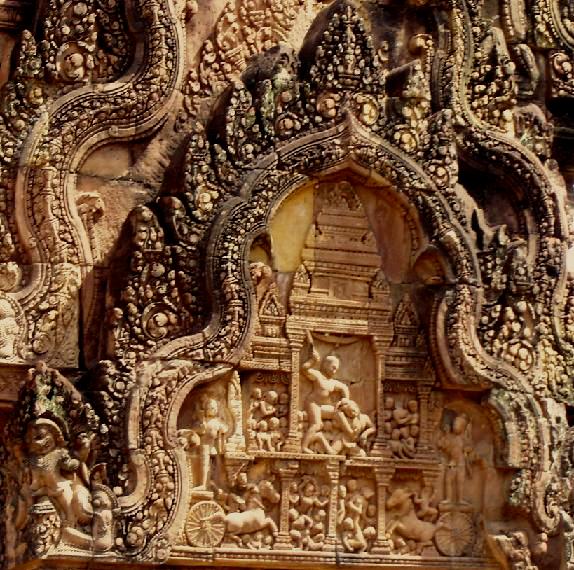
Krishna
killing the wicked Kamsa
(image
source: webmaster's own collection of
photos taken during a recent visit).
***
Khmer temples are full of symbolism – not just in the
details of lintels and pediments, but in the architecture itself,
and on the largest scale. One of the pleasurable surprises in
discovering Khmer architecture is to realize that the logic behind
it is an attempt to recreate an entire cosmology on Earth. Nagas
themselves are rich in symbolism in both Hinduism and Buddhism:
they play a part in a number of key events, including legends, and
are associated with water.
The most common Hindu icons found in Khmer temples in
Thailand are Vishnu Reclining (Vishnu Anantasayin), Shiva Dancing
(Shiva Nataraj) and Shiva riding with Uma on the bull Nandi (Umamaheshvara);
these occur mainly on pediments and lintels. There is less
Buddhist imagery built into the architecture.
The Ramayana furnishes the material for many
lintels and pediments. Scenes from the life of Krishna also occur,
as does the Churning of the Milk of Ocean. The Hindu epics and
legends provide for a wealth of imagery.
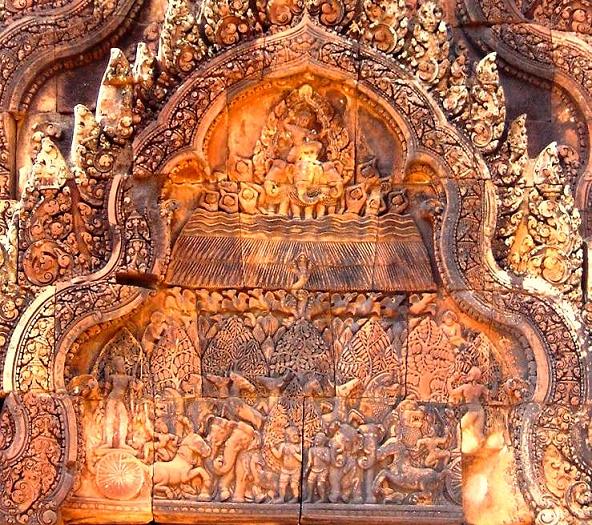
(image
source: webmaster's own collection of
photos taken during a recent visit).
***

Shiva Nataraja
dancing.
(image
source: webmaster's own collection of
photos taken during a recent visit).
Apasaras

Smiling
Apsara. Lovely detailed work showing jewelry.
In Hindu
sacred stories, Apsaras are heavenly nymphs of great beauty and charm, often
represented as dancers at the celestial court. In a number ofstories, the Gods
sent Apsaras to earth to distract and seduce sages practicing austerities -
especially those who are gaining alarming levels of yogic power through their
concentrated meditation. Apsaras would also reward heroes who fell in combat,
rushing to the battle site and carrying them into heaven.
***
Details
of the admirable Apsaras, or heavenly maidens, adorning the temple reached a
peak of perfection here. Unbelievably graceful Apsaras and Devatas inhabit this
divine world.
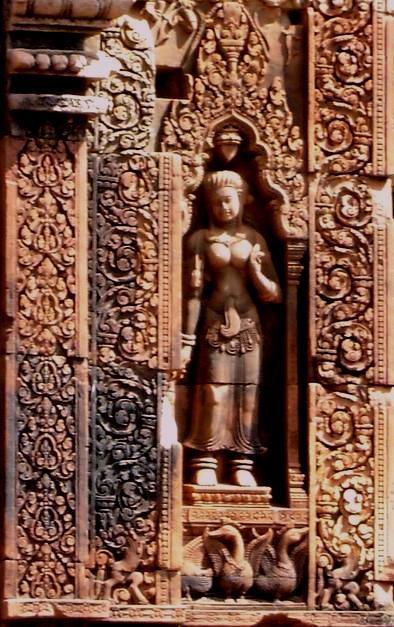
(image
source: webmaster's own collection of
photos taken during a recent visit).
***
Top
of Page
The rest of the
chapter continues at the links listed below.
Sacred Angkor
Sacred Angkor part 3
Sacred Angkor part 4
 Did You Know?
Did You Know?
The 500 year old Tamil Bell in
New Zealand
 Tamils
have long been seafarers and traders. It is believed that they reached northern
Australia by the 14th century, and there is a suggestion that they may have got
as far as New Zealand. Tamils
have long been seafarers and traders. It is believed that they reached northern
Australia by the 14th century, and there is a suggestion that they may have got
as far as New Zealand.
In
1836 the missionary explorer William Colenso found this bell, which had been
used by Māori as a cooking vessel for generations. Inscribed on it in Tamil
are the words ‘Mohoyideen Buk’s ship’s bell’. The bell is now held at
the national museum, Te Papa. Theories abound, but the precise origins of the
bell and how it got to New Zealand remain a mystery.
(source:
www.teara.govt.nz).
Refer
to India
once ruled the Americas! – By Gene D Matlock
Around
1836, the missionary William Colenso met Māori near Whangarei using the
bell as a kohua (iron pot) to cook potatoes. It is bronze, thirteen centimetres
long and nine centimetres deep, and has an inscription. Colenso
was told that the bell had been found after a heavy gale had blown down a large
tree; it was uncovered from the tree roots. Its owners believed that the bell
had been in the possession of the iwi (tribe) for several generations. Colenso
swapped an iron pot for the bell. After his death he bequeathed the bell to the
Colonial Museum, forbear to Te Papa Tongarewa.
The bell
produced a lot of interest when it was exhibited, and discussions and theories
abounded about its origins. The bell was photographed and copies sent to England
and various people in India.
Tamils in
Southern India immediately recognised the writing on the bell.
The bell has been
identified as a type of ship's bell. Some of the characters in the inscription
are of an archaic form no longer seen in modern Tamil script; thus suggesting
that the bell could be about 500 years old.
(source:
www.tepapa.govt.nz).
For
more refer to chapters on Suvarnabhumi,
Seafaring
in Ancient India, War in
Ancient India and India
on Pacific Waves? Refer
to India
once ruled the Americas! – By Gene D Matlock
For
more on The Glorious Hindu Legacy: Indic influence in Southeast Asia refer to
the chapter under Glimpses
XII to Glimpses
XIX
***
The
rest of the chapter continues...
Sacred Angkor
Sacred Angkor part 3
Sacred Angkor part 4
Top
of Page


|